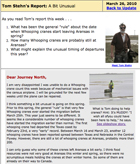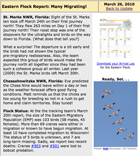Send questions before April 2
Whooping cranes are homeward bound in both the Central and Eastern flyways. They include eight 2009 crane-kids! Discover which have reached Wisconsin, including the first 2009 DAR chick. How far north are early migrants of the Western flock? Consider why small groups leave at different times. See some human actions that help cranes in our slideshow and this photo.
Today's Report Includes:
- Migration News: Map and Field Reports
- Journal: Travel Groups
- Slideshow: Crab Trap Pickup Helps Cranes
- Lesson: What Kind of Journey Lies Ahead?
- Links: Helpful Resources to Explore
Image of the Week
 Western Flock News |
 Data /Map |
 Eastern Flock News and Arrival Log |
|
Tom Stehn says a considerable number of Whooping cranes have started the migration earlier than normal. What might explain it? How many are left at Aransas, and what's Tom's question for you? |
|
Which of the '09 crane kids and several older birds have already completed spring migration to Wisconsin? Which eight of the St. Marks 10 are headed north? How are the 9 Chass chicks? See the news! |
In this week's field reports you read about the crane departures in each flock. Is it what you expected? Is it what the experts expected? Tom Stehn offers this week's question, well worth thinking about:
- "Can you think of reasons why it might be an advantage for Whooping cranes to (1)migrate in small groups and (2)leave at different times?"
Write your thoughts in your journal.
Next week Tom will share his answer, learned from more than 30 years of observing Whooping cranes.

Photo Matt Strausser, ICF
You know how important blue crabs are to the winter diet of Whooping cranes. Crabs are in demand by humans, too. Over many decades, abandoned commercial crab traps had been scattered throughout Texas bays. These abandoned traps became a big problem. But starting in 2002, a Texas Parks and Wildlife Department (TPWD) regulation — and many helpful volunteers — have greatly reduced the number of abandoned traps. Find out how in Tom Stehn's slideshow story. As usual, Tom has some questions for you! Jump into your waders and mud clothes. Here we go: Crab Trap Pickup Helps Cranes.
Cranes in
the Aransas/Wood Buffalo flock often fly 6-8 hours a day on a 2,400-mile
migration that can take as long as a month. Cranes in the Wisconsin/Florida
flock fly over 1,200 miles on their journey north. Migration is the
time
when the cranes encounter the most danger. Why do these endangered birds
make
such
a long
trip?
What perils do they face?
Humans are part of
the problems but also part of the solutions. See why as you read Migration:
A Dangerous Journey.
- Teachers/Overview: About This Study
- Image of the Week: What is this, and how does it help migrating cranes?
- Field Report: Western Flock
- Field Report: Eastern Flock
- Slideshow: Crab Trap Pickup Helps Cranes
- Nonfiction/Lesson: Migration: A Dangerous Journey
- Photo Study: What is missing on #907's leg?
- Resource: Quick-View Leg Band Chart: Class of 2009
- Making Good Sightings: Official WCEP Reporting form
- Record Keeping: Arrival Log for Eastern Flock
- Journal: Downloadble Journey North Journal Pages
The Next Whooping Crane Migration Update Will Be Posted on April 2, 2010.






